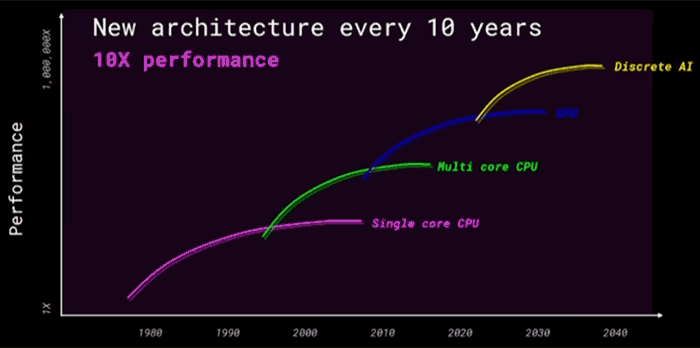UC Berkeley EECS Events has shared a recording of the Jim Keller: Moore's Law is Not Dead on YouTube (embedded below). Keller has made this talk a number of times before, but this is a recent one, having been recorded on Wednesday, 18th September, 2019. With a title like 'Moore's Law is Not Dead' the talk is designed to stir up some thoughts and discussions among computer processor designers and engineers, industry commentators and analysts, and even PC/ tech enthusiasts.
Back on the Moore's Law curve? FFWD to 33 mins 30 sec.
For those always looking for the next big thing, significant intergenerational performance leaps, and more speed from their PC processor - the apparent slowing down of progress in the CPU-world has been a bit disheartening. However, Keller has a plan, and is working at Intel now with hopes to implement it.
Sunny Cove is probably the biggest IPC leap in years from Intel (with 15 to 18 per cent IPC boost over Skylake) and it made its debut in the firm's Ice Lake chips not long ago, albeit in mobile parts, with new Gen11 graphics in tow too. Now it is up to Keller and team to push forward and make a bigger difference. It is his intention to gain performance on a Sunny Cove successor by implementing a "significantly bigger" core than used for this most recently shipping architecture.
Really big mindset change at Intel
Keller went on to state that Intel has a roadmap featuring processors with 50x more transistors, and other smarter features such as better data and branch prediction, an improved instruction set architecture, plus better optimisation. This will be more than enough to put Intel back much "closer to the linear curve on performance," underlining that "this is a really big mindset change".

You can see that Keller believes 'Discrete AI' will play a major part in the next intergenerational performance boost (following on from multi-core, and GPU assistance boosts).
The above might sound exciting, especially given Keller's reputation for changing things up. However, some might see the announcements as 'jam tomorrow' for investors. Intel's Ice Lake desktop chips aren't even out yet, with expectations that they will arrive in late 2020 to 2021. Then the architectural successor to Sunny Cove (Willow Cove) isn't supposed to be anything other than an incremental update. Keller might be referring to Golden Cove, which could debut sometime in 2021, as it has been earmarked as an 'ST Perf' upgrade. Last but not least, the competition continues to move forward, now with good momentum, so Intel is under pressure to make meaningful changes swiftly.






